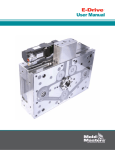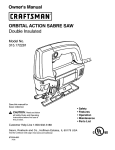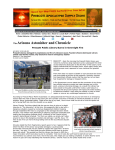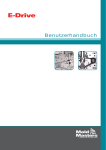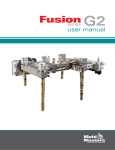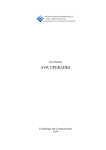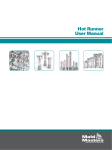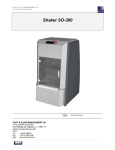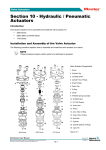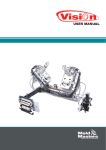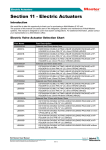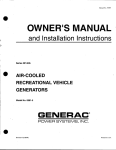Download User Manual E-DriveTM - Mold
Transcript
E-Drive User Manual TM Table of Contents Table of Contents Section 1 - Introduction...................................................... 1-1 Warranty and Documentation........................................................................................... 1-1 Release Details.................................................................................................................... 1-1 Trademarks and Patents..................................................................................................... 1-2 Section 2 - Global Support................................................. 2-1 Manufacturing Facilities..................................................................................................... 2-1 Regional Offices.................................................................................................................. 2-1 International Representatives............................................................................................ 2-2 Section 3 - Safety................................................................ 3-1 Introduction......................................................................................................................... 3-1 Safety Hazards.................................................................................................................... 3-1 E-Drive Safety Warnings.................................................................................................... 3-4 E-Drive Cautions................................................................................................................. 3-4 Mag-Pin Safety.................................................................................................................... 3-4 Section 4 - Preparation....................................................... 4-1 Introduction......................................................................................................................... 4-1 Screw Lengths.................................................................................................................... 4-1 Tools Required.................................................................................................................... 4-2 Unpacking........................................................................................................................... 4-3 Cleaning............................................................................................................................... 4-3 Establishing Your System Type.......................................................................................... 4-3 Typical E-Drive System...................................................................................................... 4-4 E-Drive Components.......................................................................................................... 4-6 E-Drive User Manual Not under documentation control if printed. May be revised without notice Electronic version is available at www.moldmasters.com i Revision 05 ©09-2010 Table of Contents Section 5 - Assembly........................................................... 5-1 Introduction......................................................................................................................... 5-1 Complete Assembly (3D View)........................................................................................... 5-1 Complete Assembly (Center Section)............................................................................... 5-1 Assembly Summary........................................................................................................... 5-2 Assembly Details................................................................................................................ 5-2 First Time Installation or Replacement of the Belt..........................................................5-14 Checking for Misalignment...............................................................................................5-15 Section 6 - Mag-Pin Option................................................ 6-1 Introduction......................................................................................................................... 6-1 Mag-Pin Assembly (3D View)............................................................................................. 6-1 Mag-Pin Application Cautions........................................................................................... 6-2 Mag-Pin Activation / Deactivation..................................................................................... 6-2 Handling Magnets.............................................................................................................. 6-3 Assembly Summary........................................................................................................... 6-4 Assembly Details................................................................................................................ 6-4 Mag-Pin Extraction............................................................................................................. 6-9 Section 7 - Maintenance..................................................... 7-1 Introduction......................................................................................................................... 7-1 Recommended Maintenance ............................................................................. 7-1 Lubrication of Ball-Screw Assembly................................................................................. 7-1 Inspection of the Timing Belt............................................................................................. 7-1 Replacement of Bearings................................................................................................... 7-1 Assembly / Disassembly of Top Plate................................................................................ 7-2 Index..................................................................................Index-i E-Drive User Manual Not under documentation control if printed. May be revised without notice Electronic version is available at www.moldmasters.com ii Revision 05 ©09-2010 Introduction Section 1 - Introduction We would like to take this opportunity to thank you for purchasing a Mold-Masters® E-Drive™system. The purpose of this manual is to assist users in the integration, operation and maintenance of their E-Drive system. This manual also provides information related to the Mag-Pin (Magnetic Valve Pin Holder) option. Symbols Used in the Manual GENERAL DESCRIPTION OF SYMBOL WARNING Indicates an immediate or potentially hazardous situation, which if not avoided, could result in a serious injury or death. CAUTION Failure to follow instructions may damage equipment NOTE Indicates additional information or used as a reminder Warranty and Documentation Please check with your original order documentation for warranty details. NOTE Please do not return any parts to Mold-Masters without prior pre-authorization and a return authorization number supplied by Mold-Masters (2007) Limited. Documentation will include one or more of the following: • Information on the Mold-Masters E-Drive system in general and information on the Mag-Pin (Magnetic Valve Pin Holder) option. • Parts list contains all system components. Together with the general assembly drawing, the parts list should be referenced when ordering spare parts. • General assembly drawing used to integrate your E-Drive system into the mold. WARNING This manual must be used in conjunction with any appropriate Machine, Hot Runner, and Temperature Controller User Manual. When ordering this manual, please reference document number: EMMEDUM05. Release Details Document # EMMEDUM05 Release Date Version 8 September 2010 05 E-Drive User Manual Not under documentation control if printed. May be revised without notice Electronic version is available at www.moldmasters.com 1-1 Revision 05 ©09-2010 Introduction Trademarks and Patents ACCU-VALVE, DURA, FLEX-DURA FLEX-SERIES, FUSION-SERIES, HOT EDGE, INJECTIONEERING, MASTERPROBE, MASTER-SHOT, MOLD-MASTERS, MELT-DISK, MOLD-MASTERS ACADEMY, MASTERSERIES, MASTERSOLUTION, MASTERSPEED, MERLIN, MOLD-MASTERS SYSTEM, SCAN-MASTER, STACK-LINK, are the registered trademarks of MOLD-MASTERS (2007) LIMITED. Information contained herein is, to our best knowledge, true and accurate, but all recommendations or suggestions are made without guarantee. Since the conditions of use are beyond our control, MoldMasters disclaims any liability incurred in connection with the use of our products and information contained herein. No person is authorized to make any statement or recommendation not contained herein, and any such statement or recommendation so made shall not bind Mold-Masters. Furthermore, nothing contained herein shall be construed as a recommendation to use any product in conflict with existing patents covering any products or its use, and no license implied or in fact granted herein under the claims of any patents. No part of this publication may be reproduced or transmitted in any form or by any means, electronic or mechanical, including photocopy, recording, or any information storage and retrieval system without permission in writing from the publisher. All details, standards and specifications may be altered in accordance with technical development without prior notification. May be manufactured under one or more of the following U.S. Patents: 5015170, 5030084, 5046942, 5049062, 5061174, 5094603, 5106291, 5118279, 5118280, 5122050, 5125827, 5135377, 5142126, 5148594, 5206040, 5217730, 5223275, 5227596, 5227181, 5235737, 5238378, 5238391, 5268184, 5269676, 5282735, 5284436, 5299928, 5312242, 5326251, 5334008, 5334010, 5346388, 5366369, 5366370, 5387099, 5405258, 5421716, 5427519, 5429491, 5437093, 5441197, 5443381, 5460510, 5474440, 5494433, 5496168, 5507635, 5507636, 5536165, 5591465, 5599567, 5614233, 5641526, 5644835, 5652003, 5658604, 5695793, 5700499, 5704113, 5705202, 5707664, 5720995, 5792493, 5795599, 5820899, 5843361, 5849343, 5853777, 5935615, 5935616, 5935621, 5942257, 5952016, 5980236, 6009616, 6017209, 6030198, 6030202, 6062841, 6074191, 6077067, 6079972, 6095790, 6099780, 6113381, 6135751, 6162043, 6162044, 6176700, 6196826, 6203310, 6230384, 6270711, 6274075, 6286751, 6302680, 6318990, 6323465, 6348171, 6350401, 6394784, 6398537, 6405785, 6440350, 6454558, 6447283, 6488881, 6561789, 6575731, 6625873, 6638053, 6648622, 6655945, 6675055, 6688875, 6701997, 6739863, 6752618, 6755641, 6761557, 6769901, 6776600, 6780003, 6789745, 6830447, 6835060, 6840758, 6852265, 6860732, 6869276, 6884061, 6887418, 6890473, 6893249, 6921257, 6921259, 6936199, 6945767, 6945768, 6955534, 6962492, 6971869, 6988883, 6992269, 7014455, 7018197, 7022278, 7025585, 7025586, 7029269, 7040378, 7044191, 7044728, 7048532, 7086852, 7105123, 7108502, 7108503, 7115226, 7118703, 7118704, 7122145, 7125242, 7125243, 7128566, 7131832, 7131833, 7131834, 7134868, 7137806, 7137807, 7143496, 7156648, 7160100, 7160101, 7165965, 7168941, 7168943, 7172409, 7172411, 7175419, 7175420, 7179081, 7182591, 7182893, 7189071, 7192268, 7192270, 7198740, 7201335, 7210917, 7223092, 7238019, 724418, 7252498, 7255555, 7258536, 7270538, 7303720, 7306454, 7306455, 7314367, 7320588, 7320589, 7320590 7326049, 7344372, 7347684, 7364425, 7364426, 7370417,7377768, 7381050, 7396226, 7407379, 7407380, 7410353, 7410354, 7413432, 7416402, 7438551, 7462030, 7462031, 7462314, 7465165, 7470122, 7507081, 7510392, 7513771, 7513772, 7517214, 7524183, 7527490, 7544056, 7547208, 7553150, 7559760, 7559762, 7565221, 7581944, 7611349, 7614869, 7614872, 7618253, 7658605, 7658606, 7671304, 7678320, 7686603, 7703188, 7713046, 7722351, 7731489, 7753676, D525592, RE38265, RE38396, RE38920, RE39935, RE40478, RE40952 + Pending. © 2010 MOLD-MASTERS (2007) LIMITED. ALL RIGHTS RESERVED. E-Drive User Manual Not under documentation control if printed. May be revised without notice Electronic version is available at www.moldmasters.com 1-2 Revision 05 ©09-2010 Global Support Section 2 - Global Support Manufacturing Facilities GLOBAL HEADQUARTERS CANADA EUROPEAN HEADQUARTERS GERMANY / SWITZERLAND ASIAN HEADQUARTERS CHINA/HONG KONG/TAIWAN Mold-Masters Europa GmbH Postfach/P.O. Box 19 01 45 76503 Baden-Baden, Germany Neumattring 1 76532 Baden-Baden, Germany tel: +49 7221 50990 fax: +49 7221 53093 info@moldmasters.de Mold-Masters (KunShan) Co, Ltd Zhao Tian Rd Lu Jia Town, KunShan City Jiang Su Province People’s Republic of China tel: +86 512 86162882 fax: +86 512-86162883 mmc-sales@moldmasters.com SOUTH AMERICAN HEADQUARTERS BRAZIL INDIA JAPAN UNITED KINGDOM U.S.A. Mold-Masters Limited 233 Armstrong Avenue Georgetown, Ontario Canada L7G 4X5 tel: +1 (905) 877 0185 fax: +1 (905) 873 2818 info@moldmasters.com Mold-Masters do Brasil Ltda. Rua Hum, 1106 e 1126 Jd. Manchester - Nova Veneza Sumarè - São Paulo Brasil CEP 13178-440 tel: +55 19 3922 4265 fax: +55 19 3922 4266 moldmasters@moldmasters.com.br Mold-Masters UK / PMS Systems Ltd Netherwood Road Rotherwas Hereford HR2 6JU tel: +44 1432 265768 fax: +44 1432 263782 mmuk-all@moldmasters.co.uk Mold-Masters Technologies Private Limited # 247, Alagesan Road, Shiv Building, Saibaba Colony. Coimbatore T. N. India 641 011 tel: +91 422 423 4888 - 20 fax: +91 422 423 4800 mmtplinfo@moldmasters.com Mold-Masters K.K. 1-4-17 Kurikidai, Asaoku Kawasaki, Kanagawa Japan, 215-0032 tel: +81 44 986 2101 fax: +81 44 986 3145 info@mmkk.co.jp Mold-Masters Injectioneering LLC 103 Peyerk Court Romeo, MI 48065 tel: +1 800 450 2270 (USA) tel: +1 (586) 752-6551 fax: +1 (586) 752 6552 info@moldmasters.com Regional Offices AUSTRIA / HUNGARY CZECH REPUBLIC FRANCE KOREA MEXICO POLAND Mold-Masters Handelsges.m.b.H. Pyhrnstrasse 16 A-4553 Schlierbach Austria tel: +43 7582/51877 fax: +43 7582/51877 18 office@moldmasters.at Mold-Masters Korea Ltd No.1210, Byucksan Digital Valley 5 Cha, 60-73 Gasan-dong, Geumcheon-gu, Seoul,153-788,South Korea Tel:+82 2 2082 4755 Fax:+82 2 2082 4756 mmkr-sales@moldmasters.com Mold-Masters Europa GmbH Hlavni 823 75654 Zubri Czech Republic tel: +420 571 619 017 fax: +420 571 619 018 cz@moldmasters.eu Mold-Masters France ZI la Marinière, 2 Rue Bernard Palissy 91070 Bondoufle tel: +33 1 82 05 00 80 fax: +33 1 82 05 00 83 mmf-info@moldmasters.eu MM Hot Runner Injection México, S.A. de C.V. Av. San Carlos No. 4 - Nave 2 Parque Industrial Lerma Lerma, Estado de México 52000, México Tel: +52 728 282 48 33 Fax: +52 728 282 47 77 mexico@moldmasters.com E-Drive User Manual Mold-Masters Europa GmbH Skr. Pocztowa 59 00-908 Warszawa Poland tel: +48 (0) 66 91 80 888 fax: +48 (0) 66 91 80 208 pl@moldmasters.eu Not under documentation control if printed. May be revised without notice Electronic version is available at www.moldmasters.com 2-1 Revision 05 ©09-2010 Global Support Regional Offices - Con't SINGAPORE / MALAYSIA INDONESIA / THAILAND Mold-Masters Singapore PTE. Ltd. No 48 Toh Guan Road East #06-140 Enterprise Hub Singapore 608586 Republic of Singapore tel: +65 6261 7793 fax: +65 6261 8378 mmsinfo@moldmasters.com SPAIN Mold-Masters España Serennia Business Center Buenos Aires 37-29 08902 Hospitalet de Llobregat Barcelona, Spain tel: +34 93 802 36 01 fax: +34 93 802 49 08 spain@moldmasters.eu International Representatives Argentina Australia Bulgaria Denmark, Norway, Sweden Finland Hong Kong Israel Italy Portugal Romania Turkey Vietnam Sollwert S.R.L. La Pampa 2849 2∫ B C1428EAY Buenos Aires Argentinia tel: +54 11 4786 5978 fax: +54 11 4786 5978 Ext. 35 sollwert@fibertel.com.ar H. & G. Englmayer A/S Skenkelsoevej 9, Postbox 35 DK - 3650 Oelstykke, Denmark tel: +45 46 733847 fax: +45 46 733859 support@englmayer.dk ASAF INDUSTRIES Ltd. 29 Habanai Street PO Box 5598 Holon 58154 Israel tel: +972 3 5581290 fax: +972 3 5581293 sales@asaf.com International Mold Trade Co. SRL Str. Constantin Aricescu, Nr. 21 Bl. 20, Sc. 2, Apt. 20 Bucharest - Sector 1, Romania tel: +4 021 230 60 51 fax : +4 021 231 78 43 contact@matritehightech.ro Comtec I P E 1084 South Road, Edwardstown, South Australia 5039 PO Box 338, Magill, South Australia 5072 tel: +61 8 8374 4633 fax: +61 8 8299 0892 bparrington@comtecipe.com Oy Scalar Ltd. Viertolantie 12 11120 Riihimaki, Finland tel: +358 19 783 191 fax: +358 19 783 190 info@scalar.fi Nicko International Ltd. Rm 1203, Chevalier Commercial Centre 8 Wang Hoi Road, Kowloon Bay, Hong Kong tel: +852 2755 2783 fax: +852 2798 8656 sales@nicko.com.hk Commerciale Isola SPA Via G.B. Tiepolo 3 35010 Cadoneghe, (Padova), Italy tel: +39 49 706600 fax: +39 49 8874231 info@com-isola.it Gecim LDA Rua Fonte Dos Ingleses, No 2 Engenho 2430-130 Marinha Grande, Portugal tel: +351 244 575600 fax: +351 244 575601 gecim@gecim.pt MMG Consulting & Engineering Yesil Çesme Sok No:30/3 Çiftehavuzlar 81060, Istanbul, Turkey tel: +90 216 357 0783 fax: +90 216 385 0656 mustafa.gevrek @mmgmuhendislik.com E-Drive User Manual Mold-Trade OOD 62, Aleksandrovska St. Ruse City Bulgaria tel: +359 82 821 054 fax: +359 82 821 054 contact@mold-trade.com Lotus Chemical Technology 393 Dien Bien Phu St., Ward 4, Dist. 3, HoChiMinh City, Vietnam tel: +84 8 832 7605, fax: +84 8 832 7730 dieuphuoc.nguyen@lotusfirma.com Not under documentation control if printed. May be revised without notice Electronic version is available at www.moldmasters.com 2-2 Revision 05 ©09-2010 Safety Section 3 - Safety Introduction Any instructional material provided by Mold-Masters for the operation and maintenance of equipment, does not in any way absolve the employer from fulfilling the following obligations and Mold-Masters disclaims liability for injury to personnel using equipment supplied. It is the responsibility of the employer to: • Ensure the original and continuing competence of personnel caring for, setting up, inspecting and maintaining injection molding equipment. • Establish and follow a program of periodic and regular inspections of injection molding equipment to ensure they are in safe operating condition and proper adjustment. • Ensure that no modifications, repairs, or rebuild of portions are made to the equipment that reduces the level of safety existing at time of manufacture or remanufacture. Safety Hazards The following safety hazards are most commonly associated with plastic injection molding equipment (From the American National Standard for Plastics Machinery Horizontal Injection Molding Machines-ANSI/ SPI B151.1- 2007). WARNING For Safety Information also refer to all machine manuals and local regulations and codes. 2 (1) Mold area 10 5 3 (2) Clamping mechanism area (3) Area of movement of core and ejector drive mechanisms outside areas 1& 2 (4) Nozzle area (5) Plasticizing and or injection unit area (6) Feed opening area Top View with Guards Removed (7) Area of the heater bands of the plasticizing and/or injection cylinders 9 1 2 (8) Parts discharge area 5 4 6 7 (9) Hoses (10) Area inside the guards and outside the mold area 8 • Figure 3-1: Injection molding machine (HIMM) with horizontal clamping unit and horizontal injection unit, shown without guards for illustration clarity. Front View with Guards Removed E-Drive User Manual Not under documentation control if printed. May be revised without notice Electronic version is available at www.moldmasters.com 3-1 Revision 05 ©09-2010 9 Safety Hazard Area Potential Hazards Mold Area Mechanical Hazards Area between the plat- Crushing and/or shearing and/or impact hazards caused by: • Movement of the platen Movements of the injection barrel(s) into the mold ens. area Movements of cores and ejectors and their drive mechanisms. See Figure 3-1 item 1 • Tie bar motion. Thermal Hazards • Burns and/or scalds due to operating temperature of: • The mold heating elements of the molds. • Plasticized material released from/through the mold. Clamping Mechanism Area See Figure 3-1 area 2 Mechanical Hazards Crushing and/or shearing and/or impact hazards caused by: • Movement of the platen. • Movement of the drive mechanism of the platen. • Movement of the core and ejector drive mechanism. Movement of drive mechanisms outside the mold area and outside the clamping mechanism area. See Figure 3-1 area 3 Mechanical Hazards Mechanical hazards of crushing, shearing and/or impact caused by the movements of: • Core and ejector drive mechanisms. Nozzle area Mechanical Hazards The nozzle area is the Crushing, shearing hazards, and/or impact hazards caused by: area between the bar- • Forward movement of the plasticizing and/or injection unit including rel and the sprue bushnozzle. ing. • Movements of parts of-the power operated nozzle shutoff and their drives. See Figure 3-1 area 4 • Over pressurization in the nozzle. Thermal Hazards Burns and or scalds due to operating temperature of: • The nozzle. • Plasticized material discharging from the nozzle. Plasticizing and/or injection unit area Area from the adaptor/barrelhead/end cap to the extruder motor above the sled including the carriage cylinders. See Figure 3-1 area 5 Mechanical Hazards Crushing, shearing and/or drawn into hazards caused by: • Unintentional gravity movements e.g. for machines with plasticizing and/or injection unit positioned above the mold area. • The movements of the screw and/or the injection plunger in the cylinder accessible through the feed opening. • Movement of the carriage unit. Thermal Hazards Burns and or scalds due to operating temperature of: • The plasticizing and/or injection unit. • The heating elements e.g. heater bands. • The plasticized material and/or vapors discharging from the vent opening, feed throat or hopper. Mechanical and/or Thermal Hazard Hazards due to reduction in mechanical strength of the plasticizing and/or injection cylinder due to overheating. E-Drive User Manual Not under documentation control if printed. May be revised without notice Electronic version is available at www.moldmasters.com 3-2 Revision 05 ©09-2010 Safety Hazard Area Potential Hazards Feed Opening See Figure 3-1 area 6 Pinching and crushing between injection screw movement and housing. Area of the heater Burns and or scalds due to operating temperature of: bands of the plasticiz- • The plasticizing and/or injection unit. ing and/or injection • The heating elements e.g. heater bands. • The plasticized material and/or vapors discharging from the vent opening, cylinders feed throat or hopper. See Figure 3-1 area 7 Parts Discharge Area See Figure 3-1 area 8 Mechanical Hazards Accessible Through the Discharge Area Crushing, shearing and/or impact hazards caused by: • Closing movement of the platen Movements of cores and ejectors and their drive mechanisms. Thermal Hazards Accessible Through the Discharge Area Burns and or scalds due to operating temperature of: • The mold. • Heating elements of the mold. • Plasticized material released from/through the mold. Hoses See Figure 3-1 area 9 • Whipping action caused by hose assembly failure. • Possible release of fluid under pressure that can cause injury. • Thermal hazards associated with hot fluid. Area Inside the Guards Crushing and/or shearing and/or impact hazards caused by: and Outside the Mold • Movement of the platen. Area • Movement of the drive mechanism of the platen. See Figure 3-1 area 10 • Movement of the core and ejector drive mechanism. • Clamp opening movement. Electrical Hazards • Electric shock or burns due to contact with live conductive parts. • Electrical or electromagnetic disturbance generated by the motor control unit. • Electrical or electromagnetic disturbance that can cause failures in the machine control systems and adjacent machine controls. • Electrical or electromagnetic disturbance generated by the motor control unit. Hydraulic Accumulators High pressure discharge. Power Operated Gate Crush or impact hazards caused by the movement of the power operated gates. Vapors and Gases Certain processing conditions and or resins can cause hazardous fumes or vapors. E-Drive User Manual Not under documentation control if printed. May be revised without notice Electronic version is available at www.moldmasters.com 3-3 Revision 05 ©09-2010 Safety E-Drive Safety Warnings Never touch or inspect the timing belt when power is on and E-Drive motor and controller are connected. Unplug the controller before any maintenance. Do not operate the equipment with unconfined long hair, loose clothing or jewellry, including name badges, neckties, etc. These may get caught by the moving belt mechanism and can cause death or serious injury. Always cover belt area with proper protecting sheet before any bench test or in-mold testing. High Voltage and amperage cables are connected to E-drive controller (220VAC). Also there is high voltage cable connection between servo motor and controller. Unplug the controller before performing any maintenance work. E-Drive Cautions Make sure the controller power supply is unplugged (or turned off) before plugging in the cables of the motor. Otherwise it can cause damage to the motor (do not "hot-plug" the motor!). Carefully read the instructions before operating the equipment. If in doubt, contact Mold-Masters for clarification. E-Drive components are rated to operate at temperatures less than 70ºC (158ºF). Do not heat the hot runner system without connecting a proper cooling system. In addition, if in your application mold temperature needs to be set above 70ºC (158ºF), use proper mold design for high temperatures. In high temperature applications, an additional insulation plate and support plate need to be installed above the manifold plate (See E-Drive Catalogue Pages). In addition, plates above manifold plate need to be cooled with separate cooling line set at lower temperatures (recommended temperature is below 50ºC). Mag-Pin Safety WARNING When the E-Drive system is equipped with a magnetic valve pin holder in the synchro-plate it is equipped with very strong magnets. Be careful of potential pinch hazards when handling the magnets. CAUTION Assembly of the magnetic valve pin holder parts must be done in a clean area that is free of metal chips. Ensure parts are clean of metal before assembly. Do not place the magnets close to other magnets or other ferromagnetic parts. Their light weight and high magnetic strength can cause a powerful collision force that may cause the magnet to chip or break due to impact. E-Drive User Manual Not under documentation control if printed. May be revised without notice Electronic version is available at www.moldmasters.com 3-4 Revision 05 ©09-2010 Preparation Section 4 - Preparation Introduction The following section is a step-by-step guide to preparing your Mold-Masters E-Drive system for use. Screw Lengths WARNING The use of an incorrect size, length and grade screw could cause the screw to shear, fatigue or stretch beyond its yield point, resulting in expensive downtime of the hot runner. Be aware of warnings placed on the assembly drawings. When the manifold is heated the metal expands stretching the mounting screws, if screw lengths are shortened there is a possibility of shearing. The expansion factor is calculated into the length of each screw size. WARNING DO NOT SHORTEN SCREW S.H.C.S. M12 X 130 (ISO-GRADE 12.90 OR ½ - 13 X 4.75 (ASTM A574) NOT SUPPLIED BY MOLD-MASTERS E L P M A EX E-Drive User Manual Not under documentation control if printed. May be revised without notice Electronic version is available at www.moldmasters.com 4-1 Revision 05 ©09-2010 Preparation Tools Required Depending on the size and complexity of your hot runner system, you will require most of the tools and materials listed below. • Allen keys - Set of imperial size keys and metric sizes 4, 5, 6, 8 and 10 mm for use on both imperial and metric cap screws (depending on system) • Anti-seize compound - To prevent oxidation of screw threads that could cause screws to seize with high temperatures • Solvents (denatured alcohol) - For removal of rust inhibitors • Calibrated torque wrench - For consistent screw pressure throughout the system • Pliers - For general assembly work • Circlip pliers - To remove and install Circlip in valve systems • Micrometer - (sizes 0 - 6” and 0 - 150 mm) To check system part and plate thickness • Depth micrometer - To check bore depths • Slot head screw driver - Used in installing thermocouples and ground wires • Slot head screw driver (small) - Used in fastening electrical wires to connectors • Crimping tool - For fastening connector pins when necessary • Wire strippers - For preparing wires • Utility knife - For cutting tape, wires etc. • Glass tape - Used for grouping wires into zones • Bluing Compound - For checking face contact • Sockets • Lapping compound for valve gate systems • Plastic face hammer • Valve pin pulling tool • Long M5 hex key with T-handle and snap ring in tip (Mold-Masters item number: KEY-BPHEXTKEY5.0) • Grease: Castrol Longtime PD2 (Mold-Masters part number: 104L1105I) • Proper Valve Pin extraction tools E-Drive User Manual Not under documentation control if printed. May be revised without notice Electronic version is available at www.moldmasters.com 4-2 Revision 05 ©09-2010 Preparation Unpacking 1. Carefully remove all components from the shipping box and check that all components listed on the parts list were supplied. 2. Check that all mold base dimensions are correct and correspond to Mold-Masters general assembly drawings. Cleaning All nozzles, manifolds and hot runner components must be free of the rust inhibitor applied at the factory. 1. Disassemble the system. 2. Wipe down nozzle body. 3. Remove the part and wipe clean. 4. If necessary, use a cotton swab to clean narrow interior surfaces or screw threads. For larger surfaces, such as mold plates use thinner in spray form to clean channels and recesses. Establishing Your System Type The following pages are to be used as a general guide to assist in identifying components. Refer to your general assembly drawings for specific component lists. E-Drive User Manual Not under documentation control if printed. May be revised without notice Electronic version is available at www.moldmasters.com 4-3 Revision 05 ©09-2010 Preparation Typical E-Drive System Insulation Plate Locating Ring Top Plate Servo Motor Interface Plate Tensioning Screw & Lock Nut Gear Head Idler Pulley -without teeth (2) Drive and Tensioning Pulley Ball-Screw Pulley (2) Timing Belt Tensioning Idler Pulley Tensioning Idler Screw E-Drive User Manual Not under documentation control if printed. May be revised without notice Electronic version is available at www.moldmasters.com 4-4 Revision 05 ©09-2010 Preparation Synchro-Plate Inlet Extension Tensioning Idler Assembly Synchro-Plate Valve Pin Holder Ball-Screw Assembly Valve Pin Synchro-Plate Guiding E-Drive User Manual Not under documentation control if printed. May be revised without notice Electronic version is available at www.moldmasters.com 4-5 Revision 05 ©09-2010 Preparation E-Drive Components Ball-Screw Assembly Tensioning Idler Assembly E-Drive Motor Mount - exploded view Fix Idler (without teeth) E-Drive User Manual Not under documentation control if printed. May be revised without notice Electronic version is available at www.moldmasters.com 4-6 Revision 05 ©09-2010 Assembly Section 5 - Assembly Introduction Your Mold-Masters E-Drive system is shipped pre-assembled and requires minimal pre-installation assembly. The following details the assembly/installation procedures for various components of the E-Drive. Complete Assembly (3D View) Complete Assembly (Center Section) Optional Custom Clamp Plate Shown Ballscrew Fixed Bearing (Angular Contact Bar Bearing) Floating Bearing (Ball Bearing) E-Drive User Manual Not under documentation control if printed. May be revised without notice Electronic version is available at www.moldmasters.com 5-1 Revision 05 ©09-2010 Assembly Assembly Summary 1. Assemble the hot runner system. 2. Assemble the hot runner system to manifold plate. 3. Assemble the interface plate. 4. Assemble the synchro-plate. 5. Drop the synchro-plate to place. 6. Assemble the valve pin holders. 7. Assemble all top plate items (ball-screw assembly needs to be filled with proper grease before shipping, see "Lubrication of Ball-Screw Assembly"). 8. Prepare top plate assembly before lowering. 9. Attach the synchro-plate to top plate assembly. 10. Tighten the belt (if first time installation of belt or replacing belt, refer to “replace The Belt Or First Time Installation of the Belt”). 11. Inspect parallelism of the synchro-plate. 12. Assemble the special clamping plate (if exists). 13. Assemble the insulation plate & locating ring. 14. E-Drive controller checks. 15. Preparation for shipping. Assembly Details 1. Assemble the hot runner system. E-Drive User Manual Not under documentation control if printed. May be revised without notice Electronic version is available at www.moldmasters.com 5-2 Revision 05 ©09-2010 Assembly 2. Assemble the hot runner system to manifold plate. 3. Assemble the interface plate: • Main leader pins. • Synchro-plate leader pins. • Bearing and retainers. • Fastening screws between plates. E-Drive User Manual Not under documentation control if printed. May be revised without notice Electronic version is available at www.moldmasters.com 5-3 Revision 05 ©09-2010 Assembly 4. Assemble the synchro-plate (without ball-nut). Top stop buttons (if needed) Ball-nut flange seating area Guide bushings with top/bottom retainers Bottom stop buttons 5. Drop the synchro-plate into place. Check for smooth up/down movement of synchro-plate E-Drive User Manual Not under documentation control if printed. May be revised without notice Electronic version is available at www.moldmasters.com 5-4 Revision 05 ©09-2010 Assembly 6. Assemble the valve pin holders. Valve pin holders 7. Assemble all top plate items (details follow). Assemble the ball-screw assemblies, pulley assemblies, motor mount assembly, guide bushes and belt (release tension from belt). Flange Nut E-Drive User Manual Not under documentation control if printed. May be revised without notice Electronic version is available at www.moldmasters.com 5-5 Revision 05 ©09-2010 Assembly 7.1 Prepare the ball-screw. 7.1.1 Assemble the ball-screw and fixed bearing. 7.1.2 T orque the ball-screw nut (M20 x 1.0) to 19Nm (14 Ft-lb). 7.1.3 M ake sure the bearing is seating properly in place. 7.2 Assemble the ball-screw to the top plate. 7.2.1 C heck dimension of fixed bearing bores in top plate before assembly. 7.2.2 Insert the ball-screw and fixed bearing into top plate (press-fit). Bearing will protrude 0.10mm to get loaded by the cover. E-Drive User Manual Not under documentation control if printed. May be revised without notice Electronic version is available at www.moldmasters.com 5-6 Revision 05 ©09-2010 Assembly 7.3 Fasten cover plate into position. 7.4 Assemble ball-nut on ball-screw. 7.4.1 N ote: do not disassemble the arbor from ball-nut before getting ready for assembling it into the ball-screw. 7.4.2 B all-screw mounting kit is standardized as EDRIVEBSMNTKITP and is supplied with the system. ote: arbor needs to be placed N properly against ball-screw when rotating the ball-screw. Failure to do so may result in balls falling out of assembly. It would be very difficult to reassemble the balls and unit may have to be scrapped. 7.4.4 K eep the arbor and rubber rings in a safe place. You will need them for disassembly of the ball-screw from ball-nut. E-Drive User Manual Not under documentation control if printed. May be revised without notice Electronic version is available at www.moldmasters.com 5-7 Revision 05 ©09-2010 Assembly 7.5 Assemble ball-screw and ball-nut. 7.5.1 The nut is to be mounted as follows: Remove the rubber ring from one end of the mounting arbor. Push the mounting arbor with nut until it bears against the end of the thread. The arbor must make contact with no axial clearance. 7.5.2 C arefully turn the nut unit onto the thread, applying only slight thrust. 7.5.3 R emove the arbor only when the nut unit is fully located on the screw thread. 7.6 Release the tension of the belt. 7.6.1 L oosen motor mount screws (just to be able to slide it). 7.6.2 Release the locknut on tensioning screw. 7.6.3 R otate the tensioning screw clockwise to loosen the belt. Motor mount screws Tensioning screw & lock nut E-Drive User Manual Not under documentation control if printed. May be revised without notice Electronic version is available at www.moldmasters.com 5-8 Revision 05 ©09-2010 Assembly 8. Prepare top plate assembly before lowering. 8.1 Belt should be loose / tension free. 8.2 B oth flange-nuts should be at proper orientation and same level before top-plate is lowered down for assembly. Gauge Block 9. Attach the synchro-plate to top plate assembly. Using tool KEY-BPHEXTKEY5.0, place the M6 screws that connect the ball-nut flange to the synchro-plate and then slightly tighten them. Use another hex key tool with stronger tip to fully tighten the screws. Tighten 12 screws evenly in both sides (Note: belt must be without tension) Tool KEY-BPHEXTKEY5.0 E-Drive User Manual Not under documentation control if printed. May be revised without notice Electronic version is available at www.moldmasters.com 5-9 Revision 05 ©09-2010 Assembly 9.1 ith the belt still loose, evenly rotate both ball-screws clockwise until the W synchro-plate hits the top stop buttons and is level on each side. Evenly rotate both ball-screws clockwise (Belt is still loose) 10. Tighten the belt. 10.1 L oosen motor mount screws (just to be able to slide them). 10.2 R elease the locknut on the tensioning screw. 10.3 R otate the tensioning screw Counterclockwise to tighten the belt. 10.4 Tighten the motor mount screws. Motor mount screws Tensioning screw & locknut E-Drive User Manual Not under documentation control if printed. May be revised without notice Electronic version is available at www.moldmasters.com 5-10 Revision 05 ©09-2010 Assembly 11. Inspect parallelism of the synchro-plate. If holes for inspection of synchro-plate are provided, check parallelism of the synchro-plate with proper depth gauge tools. Enlarged view Inspection holes 12. Assemble the special clamping plate (optional). E-Drive User Manual Not under documentation control if printed. May be revised without notice Electronic version is available at www.moldmasters.com 5-11 Revision 05 ©09-2010 Assembly 13. Assemble the insulation plate and locating ring. 14. Perform E-Drive Controller Checks. Before startup of the system, read "E-Drive Controller Operating Manual". CAUTION Do not swap E-Drive Controllers for different E-Drive systems without checking manual as controller setup must match mechanical system. 14.1 C heck MODE OF OPERATION (See E-Drive Controller Operating Manual). • If E-Drive system is designed to have the synchro-plate bottoming at a hard stop at close position of valve pins, E-Drive controller mode of operation should be "EndStop Mode". • If E-Drive system is designed to have the valve pins closing position set within a certain range (usually +/- 0.3mm), E-Drive controller mode of operation should be "RefPinPosition Mode". E-Drive User Manual Not under documentation control if printed. May be revised without notice Electronic version is available at www.moldmasters.com 5-12 Revision 05 ©09-2010 Assembly 14.2 C heck MECHANICAL FACTOR (See E-Drive Controller Operating Manual). • If Ball-screw assembly package name is "EDRIVEBSASM01", then Mechanical Gearing Factor needs to be set to 1.0 (hint: In such cases, shown diameter of the top pulley is D=62mm or 2.45"). • If Ball-screw assembly package name is "EDRIVEBSASM02", then Mechanical Gearing Factor needs to be set to 1.2 (hint: In such cases, shown diameter of the top pulley is D=75mm or 2.95") 15. The hot half is now ready to be installed into the mold. NOTE Make sure the synchro-plate valve pins are at the open position before shipping. E-Drive User Manual Not under documentation control if printed. May be revised without notice Electronic version is available at www.moldmasters.com 5-13 Revision 05 ©09-2010 Assembly First Time Installation or Replacement of the Belt 1. If system is new and no plastic is inside, move the synchro-plate to home position (fully open position). With proper hex keys on top of ball-screws, rotate clockwise. If system has run plastic before, make sure you heat up the system before moving the synchro-plate to fully open position. In such case, attach cooling lines to cooling system and make sure that MoldTemperature will not exceed 70ºC (158ºF) for E-Drive plates. 7. Install the taper bushing allowing the pulley to still rotate (not gripping yet). 8. Apply slight tension to engage two pulleys (check elevation of pulleys). 9. Time both ball-screw pulleys to engage in same way. 10. Tighten the taper bushing set screws on top of ball-screw pulleys (make sure the pulleys are at proper elevation and synchro-plate remains flat and seated). 2. Remove tension from belt completely from both sides (motor mount & tensioning idler). 11. Apply proper tension to belt. 3. Loosen nuts above one idler without teeth and remove the idler pulley (to allow inserting the belt in tight-belt conditions). 12. Tighten the motor mount screws. 13. Tighten the locknut on tensioning pulley. 14. Check belt height all around and make sure it is in middle of all pulleys and not rubbing on sides (measure depth of belt at various places, and check alignments). 4. Remove the taper bushing set screws on top of both ball-screw pulleys (1/4-20 UNC). NOTE: use another standard ¼-20 socket head cap screw to jack the pulley until it releases (make sure synchro-plate remains all the way up and seated flat). 15. If possible, while system is heated, do a few dry cycles (using 24 VDC manual trigger) and check movement and noise. Double check the position of belt within all pulleys. See E-Drive Controller Operating Manual. 5. Replace the belt. 6. Put back the idler without teeth and tighten the nuts. Idler tensioning screw Tensioning idler screws Taper bushing screws Use standard 1/4 - 20 socket head cap screw to jack taper lock Idler nut & pulley (without teeth) Motor mount screws Tensioning screw & locknut E-Drive User Manual Not under documentation control if printed. May be revised without notice Electronic version is available at www.moldmasters.com 5-14 Revision 05 ©09-2010 Assembly Checking for Misalignment 1. D uring belt installation and drive alignment, two types of misalignment can occur: • Parallel misalignment - is when driveR and driveN shafts are parallel, but the two pulleys lie in different planes. • Angular misalignment - is when the two shafts are not parallel. 2. A fleeting angle is the angle at which the belt enters and exits the pulleys, and equals the sum of the parallel and angular misalignments. 3. Any degree of pulley misalignment will result in some reduction of belt life, which is not accounted for in the normal drive design procedure. Misalignment of all positive belt drives should not exceed 1/4˚ or 5 mm per metre of centre distance. 4. Misalignment should be checked with a good straight edge tool. The tool should be applied from driveR to driveN and from driveN to driveR so that the effect of parallel and angular misalignment is taken into account. Parallel Misalignment fleeting angle driveR driveN Angular Misalignment fleeting angle driveR driveN E-Drive User Manual Not under documentation control if printed. May be revised without notice Electronic version is available at www.moldmasters.com 5-15 Revision 05 ©09-2010 Magnetic Valve Pin Option Section 6 - Mag-Pin Option Introduction The following provides details for the assembly/installation of the Mag-Pin (magnetic valve pin holder) which is an optional component of the E-Drive. This mechanism allows the deactivation of any individual valve pin in the synchro-plate design at press (without need to open up mold plates). A deactivated valve pin will remain at the closed position. This provides the ability to selectively shut down any cavity in a synchro-plate design. Mag-Pin Assembly (3D View) NUTLM12F-01 (locking nut) VPMAGHOLDER01 (Adjustable magnet holder) VPMAGNET01 (magnet) PN0R2-017 (O-ring for dust protection) SHCSM5X15 (recommended screws for attachment to synchro-plate) VPMAGHOUSING01 (main holder body) VPHOLDER12 (Valve pin Holder) Valve pin (STD 2.5 or 3 mm) E-Drive User Manual Not under documentation control if printed. May be revised without notice Electronic version is available at www.moldmasters.com 6-1 Revision 05 ©09-2010 Magnetic Valve Pin Option Mag-Pin Application Cautions This product is not suitable for all material and hot runner applications. Please contact Mold-Masters regarding your application. Factors that need to be considered are: • • • • Plastic material. Nozzle length. Valve pin size (only for 2.5 and 3 mm diameter valve pins). Gating style The following conditions are not recommended for Mag-Pin application: • Molding very soft and elastic materials with Durometer Hardness (Style A) less than 90 (especially for very short length nozzles). • Molding very viscous materials with very long nozzles. • Accu-Valve CX gating style. Mag-Pin Activation / Deactivation Regular operation: Nozzle is at processing temperature and gate is active. Force of magnet is high enough to hold the valve pin attached to synchro-plate during opening cycle. Deactivated gate: Nozzle is turned off and colder plastic all around valve pin holds the pin at close position. Therefore, valve pin can be detached from synchro-plate at magnet interface. SynchroPlate Open Position (Activated Gate) (8mm Stroke shown) Close Position (Both Activated & Deactivated conditions) E-Drive User Manual Open Position (Deactivated Gate) (8mm Stroke shown) Not under documentation control if printed. May be revised without notice Electronic version is available at www.moldmasters.com 6-2 Revision 05 ©09-2010 Magnetic Valve Pin Option Deactivation: After turning the nozzle Off (for 5 to 10 minutes, depending on material), plastic material around valve pin holds the pin in place and decoupling happens at magnet interface. Activation: After turning the nozzle On (for 4 to 8 minutes, depending on material), plastic material around valve pin releases the pin and magnet gets engaged at interface once actuation starts. Deactivated Activated Gate Gate Open Position Close Position Handling Magnets 1. Use supplied plastic spacers (MM Part # WASHER37) between magnets to prevent them from colliding with each other while handling and storing. 2. In addition, keep groups of magnets in a thick plastic container to avoid impact with other parts or tools. Plastic Spacer (WASHER37) Magnet WARNING Be careful of potential pinch hazards when handling the magnets. E-Drive User Manual Not under documentation control if printed. May be revised without notice Electronic version is available at www.moldmasters.com 6-3 Revision 05 ©09-2010 Magnetic Valve Pin Option Assembly Summary 1. Place the magnet on top of the valve pin holder. 2. Make sure magnet holder is clean. 3. Place the magnet holder on top of the assembly. 4. Detach the valve pin holder from the magnet holder (slide to side). 5. Place the magnet holder and magnet into the housing. 6. Assemble the nut and lock magnet holder. 7. Lubricate O-ring with a thin layer of high temperature grease and place it into the related groove on the valve pin holder. Clean excessive grease from top and side faces.. 8. Place the valve pin into valve pin holder slot and then gently place the assembly into the housing assembly. Avoid impact forces on magnet. 9. The Mag-Pin is now ready for assembly into the synchro-plate. Heat up the system and complete final valve pin height adjustment if valve pin protrusion is not correct. Assembly Details WARNING Be careful of potential pinch hazards when handling the magnets. 1. Place the magnet on top of the valve pin holder. CAUTION o not start the assembly in a workbench D with lots of metal chips and grinding powder. Assembly must be done on a clean workbench. Always use new and clean rags with no metal chips to clean the parts before assembly. Handle the magnets in a safe and thick plastic container. Do not place the magnets close to a ferromagnetic part or close to another magnet. Their light weight and high magnetic strength can cause a powerful collision force that may cause the magnet faces to chip or even break due to impact. E-Drive User Manual Not under documentation control if printed. May be revised without notice Electronic version is available at www.moldmasters.com 6-4 Revision 05 ©09-2010 Magnetic Valve Pin Option 2. Make sure magnet holder (VPMAGHOLDER01) is clean with smooth surface finish at the interface with the magnet. 3. Place the magnet holder on top of the assembly. CAUTION Make sure the surface of the magnet is clean with no oil or grease. This will allow easy assembly of magnet into magnet holder. E-Drive User Manual Not under documentation control if printed. May be revised without notice Electronic version is available at www.moldmasters.com 6-5 Revision 05 ©09-2010 Magnetic Valve Pin Option 4. 5. Detach the valve pin holder from the magnet holder (slide to the side). Place the magnet holder and magnet into housing (VPMAGHOUSING01). Rotate the magnet holder counter-clockwise with a 5mm hex key until threaded portion protrudes. E-Drive User Manual Not under documentation control if printed. May be revised without notice Electronic version is available at www.moldmasters.com 6-6 Revision 05 ©09-2010 Magnetic Valve Pin Option 6. Assemble the nut and lock magnet holder. 6.1 A ssemble the jam nut M12-1.00 (NUTLM12F-01) as shown. Note: pitch of thread is 1.00mm per turn. 0.50mm 6.2 A djust the heights to have 0.50mm gap as shown (default setting for adjustability +/- 0.50mm). Re-examine valve pin height after final assembly into synchro-plate (at heated condition). Re-adjust, as required, to ensure proper valve pin height. 7. Lubricate O-ring (PNOR2-017) with a thin layer of high temperature grease and place it into the related groove on the valve pin holder (VPHOLDER12). Clean excessive grease from top and side faces. E-Drive User Manual Not under documentation control if printed. May be revised without notice Electronic version is available at www.moldmasters.com 6-7 Revision 05 ©09-2010 Magnetic Valve Pin Option 8. P lace the valve pin into the valve pin holder slot and then gently place the assembly into the housing assembly (avoid impact forces on the magnet). 9. The Mag-Pin is now ready for assembly into the synchro-plate. Heat up the system and complete final valve pin height adjustment if valve pin protrusion is not correct. E-Drive User Manual Not under documentation control if printed. May be revised without notice Electronic version is available at www.moldmasters.com 6-8 Revision 05 ©09-2010 Magnetic Valve Pin Option Mag-Pin Extraction NOTE For this procedure Mold-Masters recommends using Extraction Tool MM Part # EXTOOL13 (see below) with Extraction Tool MM Part # EXTOOLAS01. EXTOOL13B M8 Thread M5 Thread EXTOOL13A 1. Heat the system to processing temperature, ensuring the manifold reaches temperature. 2. Extract the Mag-Pin Assemblies individually. Do not lift the whole synchro-plate while Mag-Pin Assemblies are installed. E-Drive User Manual Not under documentation control if printed. May be revised without notice Electronic version is available at www.moldmasters.com 6-9 Revision 05 ©09-2010 Magnetic Valve Pin Option 3. Remove the M5 screws securing the Mag-Pin Assembly to the Synchro-Plate. M5 Screws 3.1 Extraction Option 1: Use Extraction Tool EXTOOL13A with a M8 screw. Place Extraction Tool EXTOOL13A on top of valve pin holder. Couple Extraction Tool EXTOOLAS01 with a M8 screw and M8 washer (WASHERM8-1) and extract Mag-Pin Assembly. M8 Screw EXTOOL13A E-Drive User Manual Not under documentation control if printed. May be revised without notice Electronic version is available at www.moldmasters.com 6-10 Revision 05 ©09-2010 Magnetic Valve Pin Option 3.2 Extraction Option 2: Place Extraction Tool EXTOOL13A on top of valve pin holder. Couple Extraction Tool EXTOOLAS01 with EXTOOL13B and extract Mag-Pin Assembly. EXTOOL13B EXTOOL13A 4. If the valve pin gets stuck and the mechanism detaches from the magnet interface, you may follow one of the options given on the next page. Early disengagement of valve pin. EARLY DISENGAGEMENT OF Valve Pin E-Drive User Manual Not under documentation control if printed. May be revised without notice Electronic version is available at www.moldmasters.com 6-11 Revision 05 ©09-2010 Magnetic Valve Pin Option Option 1: Extract the valve pin and holder with a M5 screw or other adaptor with a M5 thread in front. M5 Screw Option 2: Extract the valve pin and holder using Extraction Tool EXTOOLAS01 with Extraction Tool EXTOOL13B, using M5 thread end for extraction of valve pin. M8 Thread EXTOOL13B M5 Thread E-Drive User Manual Not under documentation control if printed. May be revised without notice Electronic version is available at www.moldmasters.com 6-12 Revision 05 ©09-2010 Maintenance Section 7 - Maintenance Introduction This chapter is a guide to maintaining the Mold-Masters E-Drive system. See the Mold-Masters Hot Runner User Manual for other maintenance procedures. • Repairs that should be performed by Mold-Masters personnel are not included. • If you need an item repaired that is not included in this section, please call Mold-Masters support. The phone number and system identifier is located on the mold. Recommended Maintenance Every 6 months or 500,000 cycles (whichever comes first). Lubrication of Ball-Screw Assembly 1. Recommended grease is Castrol Longtime PD2 (MM Part # 104L1105I). 2. For first time assembly; use 4g (4cc) per ball-nut. 3. For 6 month or 500,000 cycles maintenance (whichever comes first); use 2g (2cc) per ball-nut. See "Assembly/Disassembly of Top Plate" on following page. Inspection of the Timing Belt If the timing belt becomes too loose and needs to be tensioned, follow instructions "Tightening the Belt" in Section 5. Grease line on Ball-Nuts (Ball-Screws not shown) If the timing belt is worn out and needs to be replaced, follow instructions "First Time Installation or Replacement of the Belt" in Section 5. Replacement of Bearings After 1.5 million (1,500,000) cycles, replace Fixed and Floating Bearings (Identified on page 5-1). Part Name Mold-Master Part Number Qty Fixed Bearing LBSFB001 2 per Synchro-plate Floating Bearing FBSB61904-2RS1 2 per Synchro-plate E-Drive User Manual Not under documentation control if printed. May be revised without notice Electronic version is available at www.moldmasters.com 7-1 Revision 05 ©09-2010 Maintenance Assembly / Disassembly of Top Plate Assembled System 1. Remove plates up to top-plate. 2. Remove insulation-plate. 3. Remove locating-ring and any clampplate. 4. Remove all screws on top plate. E-Drive User Manual Not under documentation control if printed. May be revised without notice Electronic version is available at www.moldmasters.com 7-2 Revision 05 ©09-2010 Maintenance 5. Remove tension from belt and remove ball-nut holder screws. Make sure hot runner system is completely heated up. Loosen 12 screws attached to ball-screw nut by a hex key tool with strong hex tip. Remove 12 screws attached to ball-screw nut plates with KEYBPHEXTKEY5.0. Remove tension from belt 6. Lift the top plate assembly carefully to have access to grease lines. CAUTION Be very careful with ball-nuts. Make sure both ball-nuts remain in proper orientation and at same elevation. If any of the ball-nuts get rotated, without having proper arbor at the end of ballscrews, balls may fall out of assembly. It would be very difficult to find and reassemble the balls and ball-nut. In such case the ball-nut may need to be scrapped. grease lines E-Drive User Manual Not under documentation control if printed. May be revised without notice Electronic version is available at www.moldmasters.com 7-3 Revision 05 ©09-2010 Index Index A Mag-Pin Extraction 6-8 Maintenance 7-1 Manifold plate 5-2 Manufacturing Facilities 2-1 Misalignment 5-15 Motor Mount 4-6 applications 6-7 Assembly 5-1 Assembly (Center Section) 5-1 B Ball-Screw 4-6 Ball-Screw Assembly 7-1 Bearings Replacement 7-1 Belt 5-14,7-1 O O-ring 6-3 C P Clamping plate 5-2 Cleaning 4-3 Components 4-6 Controller 3-4 parallelism 5-2 Patents 1-2 plastic spacers 6-3 Preparation 4-1 D R Documentation 1-1 Regional Offices 2-1,?2-2 Release Details 1-1 E S E-Drive System 4-4 G Safety 3-1 Safety-E-Drive 3-4 Safety Hazards 3-1 Safety-Mag-Pin 3-4 Screw Lengths 4-1 Symbols 1-1 synchro-plate 5-2 System Type 4-3 Global Support 2-1 grease 7-1 T F Fixed Bearing 7-1 Fix Idler 4-6 Floating Bearing 7-1 Temperatures 3-4 Tensioning Idler Assembly 4-6 Tools 4-2 top plate 5-2 Top Plate Assembly / Disassembly 7-2 Trademarks and Patents 1-2 H Hazards 3-2, 3-3 I insulation plate 5-2 interface plate 5-2 International Representatives 2-2 Introduction 1-1 U Unpacking 4-3 L V leader pins 5-3 locating ring 5-2 Valve pin holders 5-2 W M Warranty and Documentation 1-1 magnet holder 6-3 Magnets 3-4, 6-3 Mag-Pin 6-1 E-Drive User Manual Not under documentation control if printed. May be revised without notice Electronic version is available at www.moldmasters.com Index-i Revision 05 ©09-2010 www.moldmasters.com ® Mold-Masters and the Mold-Masters logo are registered trademarks of Mold-Masters (2007) Limited. © 2010. EMMEDUM05





















































